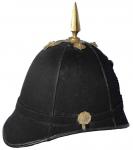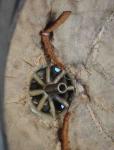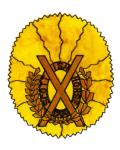-
Posts
1,761 -
Joined
-
Last visited
-
Days Won
3
Content Type
Profiles
Forums
Blogs
Gallery
Events
Store
Everything posted by Stuart Bates
-

Unit ID please
Stuart Bates replied to Tony's topic in Great Britain: Militaria: Badges, Uniforms & Equipment
The cap badge looks like Royal Engineers and the blue/white armlets are the real giveaway. Stuart -

Compton & sons: ok stamp?
Stuart Bates replied to MASteel's topic in Great Britain: Militaria: Badges, Uniforms & Equipment
I forgot to add two of the most important books on British Uniforms and they are - British Infantry Uniforms since 1660 by Michael Barthorp British Cavalry Uniforms since 1660 by Michael Barthorp I find www.bookfinder.com most useful for searching. Stuart -

Compton & sons: ok stamp?
Stuart Bates replied to MASteel's topic in Great Britain: Militaria: Badges, Uniforms & Equipment
You would also do well to invest in the Dress Regulations of the British Army. But I feel that the 1934 version would be the earliest for you. Stuart -

Compton & sons: ok stamp?
Stuart Bates replied to MASteel's topic in Great Britain: Militaria: Badges, Uniforms & Equipment
Miikka, WWI and WWII are not really my area, Victorian and Edwardian are closer to the mark, but I can recommend anything by - Brian Davis. Ray Westlake Cox Colin Churchill W.Y. Carman As a start Regards, Stuart -

Compton & sons: ok stamp?
Stuart Bates replied to MASteel's topic in Great Britain: Militaria: Badges, Uniforms & Equipment
Miikka, as I said if we all collected the same stuff far too much would be lost Good luck on your collecting and when appropriate post it on the forum. Cheers, Stuart -
TS, one has to be mindful of copyright here. I have a couple of originals which I have given to www.youroldbooksandmaps.co.uk to reproduce in CD form, but the rest are available as reprints. I suggest that you do a book search (www.bookfinder.com) to locate those copies that are still protected. Stuart
-

Home Service Helmet
Stuart Bates replied to paul w's topic in Great Britain: Militaria: Badges, Uniforms & Equipment
-

Home Service Helmet
Stuart Bates replied to paul w's topic in Great Britain: Militaria: Badges, Uniforms & Equipment
Paul, here are a couple of full-shot photos of the OR's helmet. Don't forget that the RM plate is anachronistic as they discontinued the BC in 1905 and, in any case, the date of 1907 does not gell with the QVC Stuart -

Compton & sons: ok stamp?
Stuart Bates replied to MASteel's topic in Great Britain: Militaria: Badges, Uniforms & Equipment
Miikka, I googled Compton and variations and found both Compton & Sons and Compton, Sons & Webb. From this I conclude that the two firms combined, or one took over the other. They still exist today, making uniforms etc., as Compton Webb. I also found J. Compton & Sons, Compton & Sons and Compton, Sons & Webb as button manufacturers with photographs showing the three names. It would therefore seem that the stamp is correct in all examples that you have shown. I collect British Military headgear 1768-1942, see Collectors' Showcase if you are interested, but could never get excited over a General Service Cap or "Cap, Ridiculous" as it was dubbed, but thank god that we all have different tastes as otherwise much would be lost Stuart -
TS, I could suggest that you get more Dress Regulations if you are going to pursue officers uniforms and equipment. They are a very good reference for this sort of stuff but one must always remember, and I often forget, that the rules were not always followed. I have a complete set of DRs from 1822 to 1934, at least I think it is complete, so I can always assist when needed. I don't have anything on EMs or ORs however. Stuart
-
TS, I haven't been able to find any mess dress in the DRs from 1874 to 1934 that have General and Staff officers with a scarlet jacket and a scarlet waistcoat. The following extract from the 1894 DRs, which is the same as the 1883 ones, comes closest to the jacket but the waistcoat is always blue. And the cuffs are always pointed. The collar rank badge would indicate a Lieutenant, certainly not a General or above - crossed baton/sword etc. Collar rank badges were discontinued in 1880. There were units that had scarlet for both jacket and waistcoat, the Royal Engineers for example, but I would have to say that this is not a General's mess dress. Stuart
-
TS, I have done a quick scan of my DRs from 1883 to 1934 (there is no 1906 version) and it appears that Generals always had a scarlet mess jacket with a blue waistcoat. And with pointed cuffs to the jacket. The Royal Horse Guards, the 3rd and 7th Hussars had blue jackets with scarlet waistcoats. The thin twisted cords sound more like gorget patches for Generals and Field Marshals. Can you supply a photograph of the mess jacket? Stuart
-

Home Service Helmet
Stuart Bates replied to paul w's topic in Great Britain: Militaria: Badges, Uniforms & Equipment
Here is the screw thread inside the helmet and the two leather wedges securing the west/east arms of the crosspiece. -

Home Service Helmet
Stuart Bates replied to paul w's topic in Great Britain: Militaria: Badges, Uniforms & Equipment
-

Home Service Helmet
Stuart Bates replied to paul w's topic in Great Britain: Militaria: Badges, Uniforms & Equipment
-

Home Service Helmet
Stuart Bates replied to paul w's topic in Great Britain: Militaria: Badges, Uniforms & Equipment
Well I finally took delivery of my first OR's blue cloth and my first observations are as follows - 1. 2 lugs - west and east - were used to secure the spike base, although we have seen 4 lugs used. I have a grey cloth to the Eton Rifle Volunteers which has 4. On my example there is no evidence of lugs ever having been attached to the north and south arms. 2. The spike sits inside the base rather than being proud of it as for an officer's version 3. The screw thread of the spike encroaches about 0.7" into the interior of the helmet. An accident could lead to DIY brain surgery. 4. The cloth band around the helmet is narrower than on an officers - about 0.7" to around 0.9" for the officers (0.75" was the regulation). 5. The ear rosettes are smaller on an OR's - about 1" to 1.25". 6. Forgot that the rosettes on each arm of an officer's crosspiece are not a fixture of the crosspiece but a component. This is based on only one example so I hope that other members can comment on helmets that they have. This shows the difference in the rosettes and the cloth band -

The Real Band of Brothers
Stuart Bates replied to fallschirmjager's topic in Great Britain: Research, Documentation & History
In post #22 the fellow on the cart is wearing a slouch hat and the soldier in the foreground is of a different regiment. I thought it was the "Queens" but they wore a diamond shaped flash. Over to you Leigh. Stuart -

The Real Band of Brothers
Stuart Bates replied to fallschirmjager's topic in Great Britain: Research, Documentation & History
I just went back into Barlow's booklet Uniforms of the British Yeomanry Force 1794-1914 #8 Lovat Scouts and Scottish Horse. There is a photo of officers and sergeants taken in 1901 prior to their departure to South Africa and it shows two sergeants with a backing to the badge on their slouch hats. The author maintains that the original photograph, in the Regimental Collection at Dunkeld, shows this more clearly than in the reproduction of that photo in his book. Barlow also has a photograph of the slouch with feathers and a badge with no backing at all. It is dated 1903-1914 and is an officer's. I guess some licence was taken as was usual in the British Army. GOT...TO...GET...BACK...ON...TOPIC... Stuart -

The Real Band of Brothers
Stuart Bates replied to fallschirmjager's topic in Great Britain: Research, Documentation & History
Kipling & King describe 8 variations of the Scottish Horse badge. The first two are described as - "A voided oval inscribed Scottish Horse 1900 with St Andrew's Cross superimposed. In hand-cut brass." and the next one the same but in bronze and with a yellow cloth with serrated edge. Some of the above badges did not have the date 1900 on them. This is backed up by Barlow but I think he got it from K & K as well. The one I showed is indeed dated from 1903. I will tell Ron Kidd. But K & K are saying that the yellow cloth was used during the Boer War. Fallschirmjager where did you get your information about the cloth not being used in the Boer War and the two different colours used? I know that we are getting off the original topic but all information is valuable. Stuart -

The Real Band of Brothers
Stuart Bates replied to fallschirmjager's topic in Great Britain: Research, Documentation & History
Paul, did you photograph that from a catalogue or did Bosleys supply it. I have never had a response from them other than the state of my catalogue subscription. Stuart -

The Real Band of Brothers
Stuart Bates replied to fallschirmjager's topic in Great Britain: Research, Documentation & History
Paul, where did you find this flash? Have you a date for it? It could be the one we are all after but we need a better scan of the helmet. Stuart -

The Real Band of Brothers
Stuart Bates replied to fallschirmjager's topic in Great Britain: Research, Documentation & History
Oh the power of persuasion. Leigh, you had me thinking that the letters were indeed SH but I just can't be sure. Looking at Formation Sign 229 Jan 2008, I find that according to Ron Kidd the Scottish Horse wore slouch hats with an oval rosette on the left hand side as follows - This is backed up by Barlow in the booklet Uniforms of the British Yeomanry Force 1794-1914 #8 Lovat Scouts and Scottish Horse. Stuart










